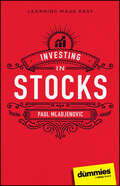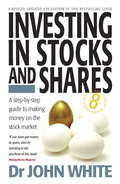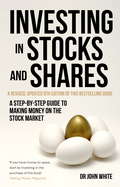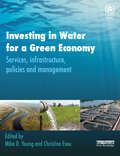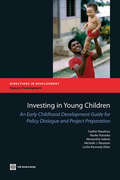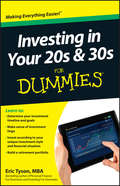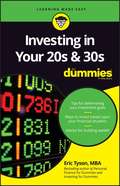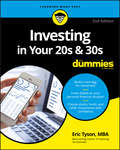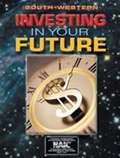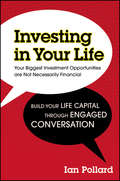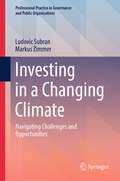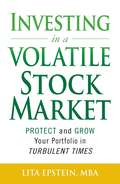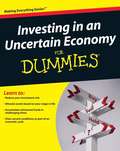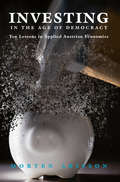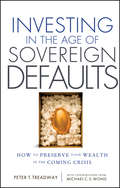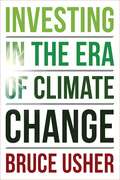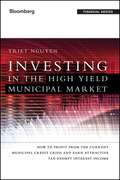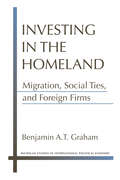- Table View
- List View
Investing in Stocks For Dummies
by Paul MladjenovicYes, you can make money in the stock market—this guide shows you how Investing in Stocks For Dummies gives you a straightforward introduction to stock investing. You’ll learn the basics of buying and selling stocks, including how to research stocks and the factors that influence their performance. Even in an uncertain and challenging marketplace, you can profit by making smart financial decisions and investing wisely. This book explains how to calculate net worth, deal with tax laws, and do all the things that will make you a successful investor. This Dummies guide is packed with clear instructions and solid advice so you can start investing with confidence. Learn how to choose the best stocks for your goals and create a diverse portfolio Understand the risks involved in stock investing and choose a strategy that works Navigate the market’s ups and downs with time-tested techniques Plan for your financial future and invest according to your timelineThe expert info in this book will start you off on the right foot as you begin your journey down Wall Street.
Investing in Stocks and Shares 8th Edition: A Step-by-step Guide To Making Money On The Stock Market (How To Ser.)
by John WhiteIf you have money to invest or a continuous surplus income, investing in stocks and shares can be the smart investment. This book, first published in 1992 is one of the most enduring guides to investment in the stock market available and has been maintained by a professional long-term investor. It explains in plain English all there is to know about what affects share prices and how to avoid unnecessary risks, and gives step-by-step guidance on: * HOW TO TRADE ON THE STOCK MARKET, WHETHER IT'S UP OR DOWN * STOCKMARKET INVESTMENT STRATEGIES * INVESTING IN TRADED OPTIONS AND FUTURES * BONDS, GILTS AND INTEREST-BEARING DEPOSITS
Investing in Stocks and Shares, 9th Edition: A step-by-step guide to making money on the stock market
by Dr John WhiteA revised, fully updated 9th edition of this bestselling book about investing in stocks and shares.This book, first published in 1992, is one of the most enduring guides to investment in the stock market ever published. Now in a thoroughly revised, updated 9th edition this bestselling volume has been written and kept up to date by a professional long-term investor. It explains in plain English how the stock market works; what affects share prices;how to avoid unnecessary risks; and how you can invest successfully in shares, bonds, gilts, options and futures over the long term. It gives step-by-step guidance on:· how to trade on the stock market, whether it's going up or down; · successful stock investment strategies; · investing at minimum risk in traded options and futures; · buying bonds, gilts and interest-bearing deposits.
Investing in Stocks and Shares, 9th Edition: A step-by-step guide to making money on the stock market
by John WhiteA revised, fully updated 9th edition of this bestselling book about investing in stocks and shares.This book, first published in 1992, is one of the most enduring guides to investment in the stock market ever published. Now in a thoroughly revised, updated 9th edition this bestselling volume has been written and kept up to date by a professional long-term investor. It explains in plain English how the stock market works; what affects share prices;how to avoid unnecessary risks; and how you can invest successfully in shares, bonds, gilts, options and futures over the long term. It gives step-by-step guidance on:· how to trade on the stock market, whether it's going up or down; · successful stock investment strategies; · investing at minimum risk in traded options and futures; · buying bonds, gilts and interest-bearing deposits.
Investing in Volatility at Evanston Capital Management
by Luis M. Viceira Adi Sunderam Zhihan MaCase
Investing in Water for a Green Economy: Services, Infrastructure, Policies and Management
by Christine Esau Michael D. YoungIn the context of the economies of the world becoming greener, this book provides a global and interdisciplinary overview of the condition of the world’s water resources and the infrastructure used to manage it. It focuses on current social and economic costs of water provision, needs and opportunities for investment and for improving its management. It describes the large array of water policy challenges facing the world, including the Millennium Development Goals for clean water and sanitation, and shows how these might be met. There is a mixture of global overviews, reviews of specific issues and an array of case studies. It is shown how accelerated investment in water-dependent ecosystems, in water infrastructure and in water management can be expected to expedite the transition to a green economy. The book provides a key source of information for people interested in understanding emerging water issues and approaches that are consistent with a world that takes greater responsibility for the environment.
Investing in Young Children: An Early Childhood Development Guide for Policy Dialogue and Project Preparation
by Naoko Kataoka Sophie Naudeau Michelle J. Neuman Alexandria Valerio Leslie Kennedy ElderThe World Bank created this Early Child Development (ECD) Guide in response to a growing demand from Task Team Leaders (TTLs) for advice and support to facilitate the policy dialogue on the topic of ECD and to help policy makers make and implement relevant choices on how to best invest in ECD in the context of their country's economy and national priorities. This Guide fills a gap in the literature by (i) distilling existing information in a user-friendly format, (ii) providing practical information on topics that have recently become particularly relevant in ECD (e.g., measuring child development outcomes through the identification and adaptation of relevant instruments, conditional cash transfers for families with young children, etc.), and (iii) assessing the quality of the latest evidence on each topic and identifying the knowledge gaps/remaining questions for which additional experimentation and evaluation are required. This Guide is designed as a series of short notes (approximately 6-8 pages each), clustered into thematic sections: (i) Initiating the policy dialogue: Why invest in ECD? (3 notes); (ii) Assessing needs, measuring outcomes, and establishing policy frameworks (2 notes); (iii) "Strategic entry points" for ECD investments (4 notes); and (iv) Costing and financing (2 notes). The notes are summarize the main debates in the field. Each note is designed to be read independently, so information is sometimes repeated or cross-referenced across notes.
Investing in Your 20s & 30s For Dummies
by Eric TysonThe easy way to make sense of investing when you're just starting outToday's 20- and 30-somethings have witnessed a miserable investment market during most, if not all, of their adult lives. But going forward, the opposite is more likely to be true. In order to build a retirement portfolio that is capable of covering expenses in your golden years, it is necessary to start saving and investing while your young. Investing in Your 20s & 30s For Dummies offers investment advice for taking the first steps as you star out on your own earning a livable income.Investing in your 20s & 30s For Dummies cuts to the chase by providing emerging professionals, like yourself, the targeted investment advice that you need to establish your own unique investment style. Covering everything from evaluating assets and managing risk to demystifying what the phrase "diversifying your portfolio" really means, this guide offers expert investment advice that you shouldn't be without.Helps you determine your investment timeline and goalsOffers plain-English explanations of investment lingoIncludes tips for investing while having debtGuidance on where and when to seek investment advice If you're in your 20s or 30s, the sooner you're investing, the more time you have to compound your returns and grow your portfolio. So what are you waiting for?
Investing in Your 20s & 30s For Dummies
by Eric TysonInvesting in Your 20s & 30s Discover your unique investing style!Now is an exciting time to get started with investments. Stock trading apps, robo-advisors, ETFs, small business ownership—setting your money in motion is a lot more fun than it used to be. And if you make your investing debut in your 20s and 30s, you can realize substantial returns by the time you retire. This book demystifies the stock market, government bonds, portfolio diversification, and beyond, so you can turn your hard-earned money into… more money! The sooner you begin, the “greener” your future will be!Inside. . .Learn how to start investingChoose stocks and funds wiselyMinimize your tax billDecide how much to investGet into real estateManage your level of riskInvest in small businessDiversify your portfolio
Investing in Your 20s and 30s For Dummies
by Eric TysonInvesting in Your 20s & 30s For Dummies (9781119293415) was previously published as Investing in Your 20s & 30s For Dummies (9781118411230). While this version features a new Dummies cover and design, the content is the same as the prior release and should not be considered a new or updated product. The easy way to make sense of investing when you're just starting out Today's 20- and 30-somethings have witnessed a miserable investment market during most, if not all, of their adult lives. But going forward, the opposite is more likely to be true. In order to build a retirement portfolio that is capable of covering expenses in your golden years, it is necessary to start saving and investing while you are young. Investing in Your 20s & 30s For Dummies offers investment advice for taking the first steps as you star out on your own earning a livable income. Investing in your 20s & 30s For Dummies cuts to the chase by providing emerging professionals, like yourself, the targeted investment advice that you need to establish your own unique investment style. Covering everything from evaluating assets and managing risk to demystifying what the phrase "diversifying your portfolio" really means, this guide offers expert investment advice that you shouldn't be without. Helps you determine your investment timeline and goals Offers plain-English explanations of investment lingo Includes tips for investing while having debt Guidance on where and when to seek investment advice If you're in your 20s or 30s, the sooner you're investing, the more time you have to compound your returns and grow your portfolio. So what are you waiting for?
Investing in Your 20s and 30s For Dummies
by Eric Tyson<p>In order to build a retirement portfolio that is capable of covering expenses in your golden years, it's necessary to start saving while you're young. Many individuals realize the importance of investing early in life, but simply don't know where to begin. <p><i>Investing in Your 20s & 30s For Dummies</i> provides emerging professionals, like yourself, with the targeted investment advice that you need to establish your own unique investment style. Covering everything from the latest tax laws to new and improved investing funds, this latest edition helps you evaluate assets and manage risk to invest money wisely, and monitor your progress. <p> <li>Start building a nest egg for retirement <li>Invest based on your own financial situation <li>Understand investment lingo <li>Have the confidence to manage your money for life <li>Determine your investment timeline and goals</li> <p> <p>There's no time like the present to start investing. So, get started today!</p>
Investing in Your Child's Future: Financial Planning for Your Child's Education
by Nicola FieldMost parents dream of giving their children the best possible education. However an education – primary, secondary and tertiary – costs money. Parents of a child born in 2006 can pay approximately $250K for a child's lifetime education according to the latest research from the Australian Scholarships Group. And costs are constantly on the rise. Investing in Your Child's Future is aimed at parents and future parents, grandparents and other family members, and covers children's education from pre-school to tertiary studies. It is designed to show readers how they can secure and contribute to their children's future and can benefit from a higher education at the institution of their choice, without sacrificing their lifestyle or financial security, and regardless of their income. Investing in Your Child's Future shows readers how they can finance all, or some, of their children's education by planning ahead, implementing simple strategies and saving money as early and as regularly as possible. When your children are young, it's easy to delay funding their education as it is not an immediate expense. However, education is a major expense, regardless of whether you choose a private or public education, and the sooner you start saving, the more money you will accumulate, and the sooner you can stop worrying about your child's future.
Investing in Your Future
by National Association of Investers Corporation StaffInvesting in Your Future leads the user step-by-step into the fascinating world of financial planning and investing.
Investing in Your Future
by National Association of Investors CorporationThis practical and accessible guide explains the benefits of long-term investment, illustrates how to evaluate mutual funds and corporations, and walks through the stock selection guide developed by BetterInvesting. The worksheets and career advice suggest the book could also be used in community college courses. The second edition devotes an entire chapter to stock selection. Annotation ©2007 Book News, Inc., Portland, OR (booknews.com)
Investing in Your Life: Your Biggest Investment Opportunities are Not Necessarily Financial
by Ian PollardThe great investors of our time have taught us many lessons about generating enormous wealth through investment; but what if we could use those principles to realize our full potential -- not only financially, but in our relationships, education and careers? In this book, businessman and executive coach Dr Ian Pollard will take you on a thought-provoking journey that will encourage you to view your conversations, relationships, opportunities and decisions in a whole new light. Pollard's multi-disciplinary approach will help you discover how to: improve your conversation and decision-making skills understand and manage your strengths and weaknesses build relationships and expand your networks change negative behaviour patterns learn from success and failure make uncertainty work better for you achieve a better work/life balance. By inspiring you to view your own development through the eyes of an investor, Investing in Your Life will help you appreciate the size of the opportunities available to you. This book will empower you to maximise your potential by actively investing in the best opportunities, and will make your life more meaningful, satisfying and rewarding.
Investing in a Changing Climate: Navigating Challenges and Opportunities (Professional Practice in Governance and Public Organizations)
by Ludovic Subran Markus ZimmerNet Zero is not enough. We have dithered so long about climate change that, by now, we would need to go to negative-emissions territory, well before 2050, to keep global warming under the iconic 1.5°C target. The national commitments made so far fall short of what is needed, and so do the investments envisioned. But even with the best of intentions, it is hard for policymakers and potential investors to discern where, in the profusion of initiatives and technologies, it would make sense to focus their attention and resources. This is where this book comes in. It offers a clear-eyed view of how far along the decarbonization path six key sectors of the economy are—namely energy, utilities, transportation, industry, buildings, and agriculture—and which areas and technologies within each sector are promising in terms of investments to advance the cause. Furthermore, a special chapter on Africa spotlights a continent that is simultaneously one of the worst affected by climate change, the most likely to see its greenhouse gas emissions increase—and the one with the greatest potential for solving the West's, and the world’s, energy transition and economic growth conundrum. As such, the book serves as a concise guide both to the state of the battle against global warming, and for investors, professionals, and policymakers to find their way through the maze of options.
Investing in a Volatile Stock Market
by Lita EpsteinProtect and Grow Your Portfolio in Turbulent Times
Investing in a Volatile Stock Market
by Lita EpsteinUnsinkable Stocks provides readers with detailed strategies on how to best protect and increase their investment portfolio against the vagaries of turbulent markets and economies. It includes information about the equities, bonds, fund, commodities, real estate, and other investment opportunities and how to organize them into a cogent plan to keep solvent and prosper in today's unpredictable market.
Investing in a Volatile Stock Market: How to Use Everything from Gold to Daytrading to Ride Out Today's Turbulent Markets
by Lita EpsteinUnsinkable Stocks provides readers with detailed strategies on how to best protect and increase their investment portfolio against the vagaries of turbulent markets and economies. It includes information about the equities, bonds, fund, commodities, real estate, and other investment opportunities and how to organize them into a cogent plan to keep solvent and prosper in today’s unpredictable market.
Investing in an Uncertain Economy for Dummies
by Sheryl GarrettInvesting in an Uncertain Economy For Dummies provides investors with focused, individualized investment strategies that enable them to conquer indecision and protect and strengthen their current financial holdings. With advice from 200 top independent financial advisers, empowered readers can make effective asset allocation decisions in the face of volatile markets.
Investing in the Age of Democracy: Ten Lessons In Applied Austrian Economics
by Morten ArissonThis book offers a structured, deductive approach to Austrian investing, beginning with an analysis of the current investing paradigm. There are five economic concepts on which the Austrian School of Economics has a unique view: Entrepreneurship, Class Probability, Capital, the Interest Rate, and Institutions. This book explains, lesson by lesson, how each of theseshapes our thinking about investing. If we follow them through their logical consequences, they leave us with a unique approach to investing. Except for the theory of probability, there has not been a comprehensive analysis of the linkages between these concepts, when it comes to investing. Although they would have been obvious to the average investor before the age of democracy, since the French and American revolutions, government interventions have steadily transformed the way we think about them (and the way we invest). Above all, Entrepreneurship and Institutions are downplayed today, while investors use Case Probability, and confuse the concepts of Money and Capital.This book offers a historical review of these interventions, to shed light on how we went from what was common sense to the status quo. Offering a sometimes technical analysis, the book examines a series of fundamental investment fallacies, their origins and how not to fall for them.
Investing in the Age of Sovereign Defaults
by Michael C. S. Wong Peter T. TreadwayAcclaimed investment experts Peter Treadway and Michael Wong explain how to protect your investments--and even profit--from the coming sovereign default crises A major sovereign default crisis is looming for the so-called developed economies of the world. The result will be a major redistribution of economic wealth and an overhaul of the international financial system on an epic scale. Investing in the Age of Sovereign Defaults: How to Preserve your Wealth in the Coming Crisis explains what lies ahead, and offers invaluable suggestions to help investors avoid massive losses. Explains why the West is headed for a major default crisis and how investors can protect themselves Contends that the value of gold will continue to rise and that sooner or later government debt, including that of the U. S. and Japan, will be shunned Written by investment experts Peter Treadway and Michael Wong The days of the economic status quo are coming to an end. Investing in the Age of Sovereign Defaults shows investors what's coming and what investors must do if they want to escape unscathed.
Investing in the Era of Climate Change
by Professor Bruce UsherA climate catastrophe can be avoided, but only with a rapid and sustained investment in companies and projects that reduce greenhouse gas emissions. To the surprise of many, this has already begun. Investors are abandoning fossil-fuel companies and other polluting industries and financing businesses offering climate solutions. Rising risks, evolving social norms, government policies, and technological innovation are all accelerating this movement of capital.Bruce Usher offers an indispensable guide to the risks and opportunities for investors as the world faces climate change. He explores the role that investment plays in reducing emissions to net zero by 2050, detailing how to finance the winners and avoid the losers in a transforming global economy. Usher argues that careful examination of climate solutions will offer investors a new and necessary lens on the future for their own financial benefit and for the greater good. Companies that reduce greenhouse gas emissions will create great wealth, and, more importantly, they will provide a lifeline for humanity.Grounded in academic and industry research, Usher’s insights bring clarity to a complex and controversial topic while illuminating the people behind the numbers. This book sets out a practical and actionable plan for investors that will alter the course of climate change.
Investing in the High Yield Municipal Market
by Triet NguyenA practical guide to profiting from the high yield municipal marketThis unique guide to the high yield municipal bond market sheds some much-needed light on this esoteric but profitable corner of the fixed-income world. It fills the void between the general reference handbooks on municipal bonds and the superficial treatment of do-it-yourself bond guides, with an emphasis on practical trading applications.Having witnessed the beginning of the modern high yield tax-exempt institutional market, author Triet Nguyen documents its historical evolution, outlines a conceptual framework for high yield tax-free investing, one that takes into account both interest rate and credit cycles, and reviews the latest historical data on municipal defaults, including for the first time the non-rated sector. Current distressed opportunities are also discussed. Along the way, Nguyen takes the time to discuss in detail the pros and cons of investing in pre-packaged high yield vehicles--from mutual funds to hedge funds to exchange-traded funds--with frank and objective insider tips on how these slickly marketed products really work. For the truly committed investor who wants to do his or her own homework, Nguyen and a group of industry experts go over the key investment considerations for several major classes of high yield tax-exempt bonds.Offers unique insights into the risk/return, trading, and liquidity characteristics of high yield municipal instrumentsIncludes interesting case studies to fully illustrate the high yield investing processWritten by an insider of both the asset management industry and the broker-dealer communityInvesting in the High Yield Municipal Market will put you in a better position to profit in this arena and help you excel in today's tough financial environment.
Investing in the Homeland: Migration, Social Ties, and Foreign Firms (Michigan Studies In International Political Economy)
by Benjamin A.T. GrahamOnce viewed as a “brain drain,” migrants are increasingly viewed as a resource for promoting economic development back in their home countries. In Investing in the Homeland, Benjamin Graham finds that diasporans—migrants and their descendants—play a critical role in linking foreign firms to social networks in developing countries, allowing firms to flourish even in challenging political environments most foreign investors shun. Graham’s analysis draws on new data from face-to-face interviews with the managers of over 450 foreign firms operating in two developing countries: Georgia and the Philippines. Diaspora-owned and diaspora-managed firms are better connected than other foreign firms and they use social ties to resolve disputes and influence government policy. At the same time, Graham shows that diaspora-affiliated firms are no more socially responsible than their purely foreign peers—at root, they are profit-seeking enterprises, not development NGOs. Graham identifies implications for policymakers seeking to capture the development potential of diaspora investment and for managers of multinational firms who want to harness diasporans as a source of sustained competitive advantage.
